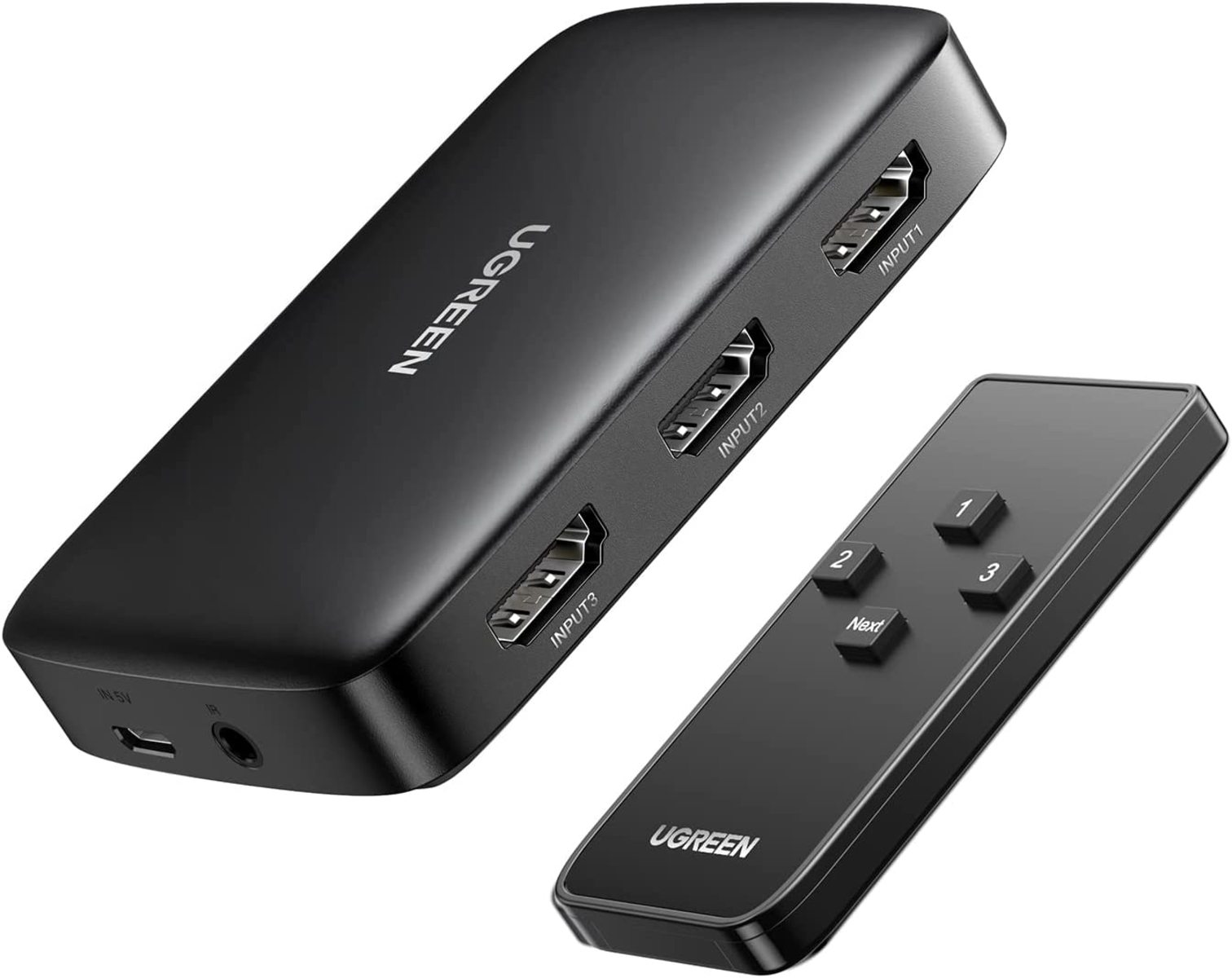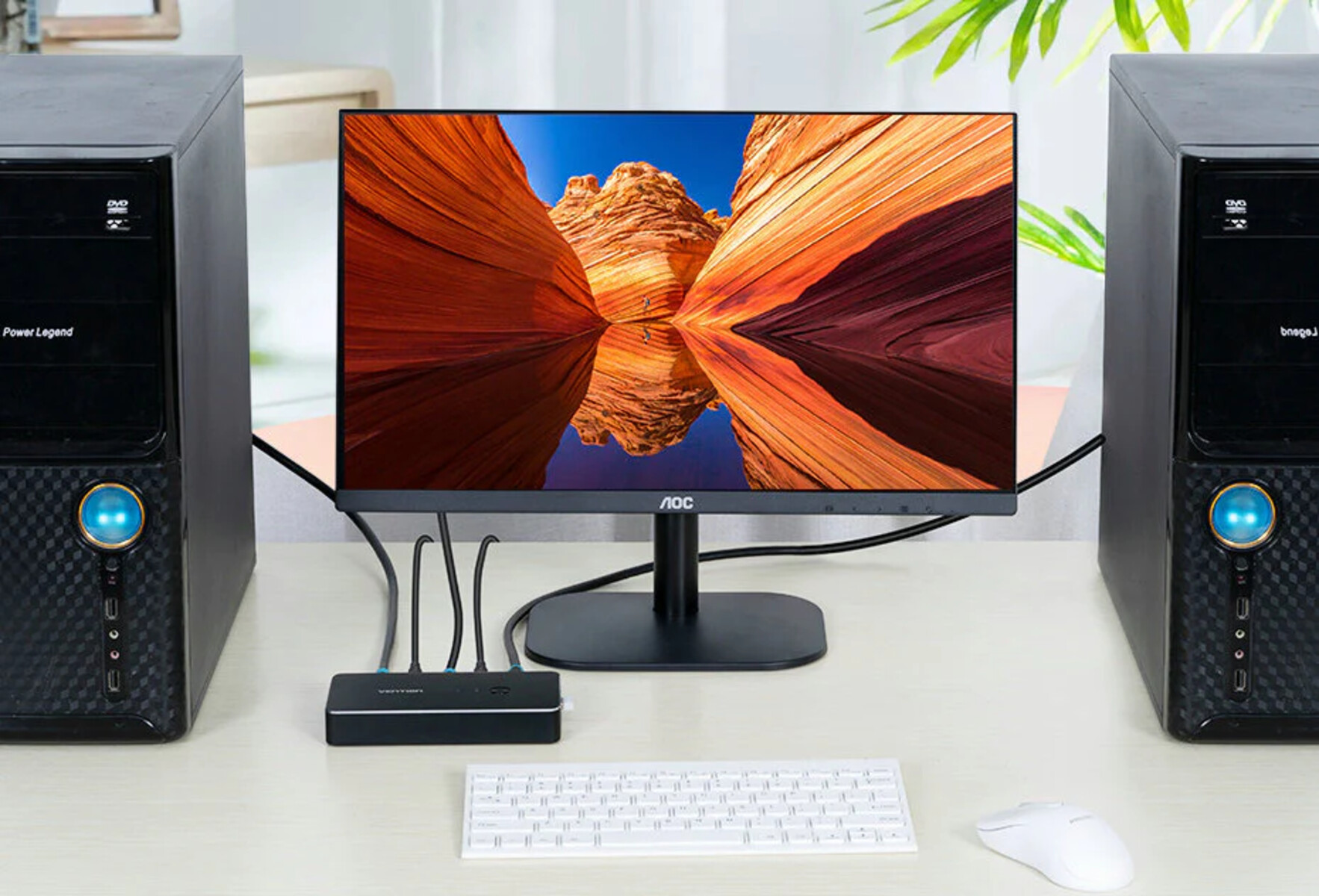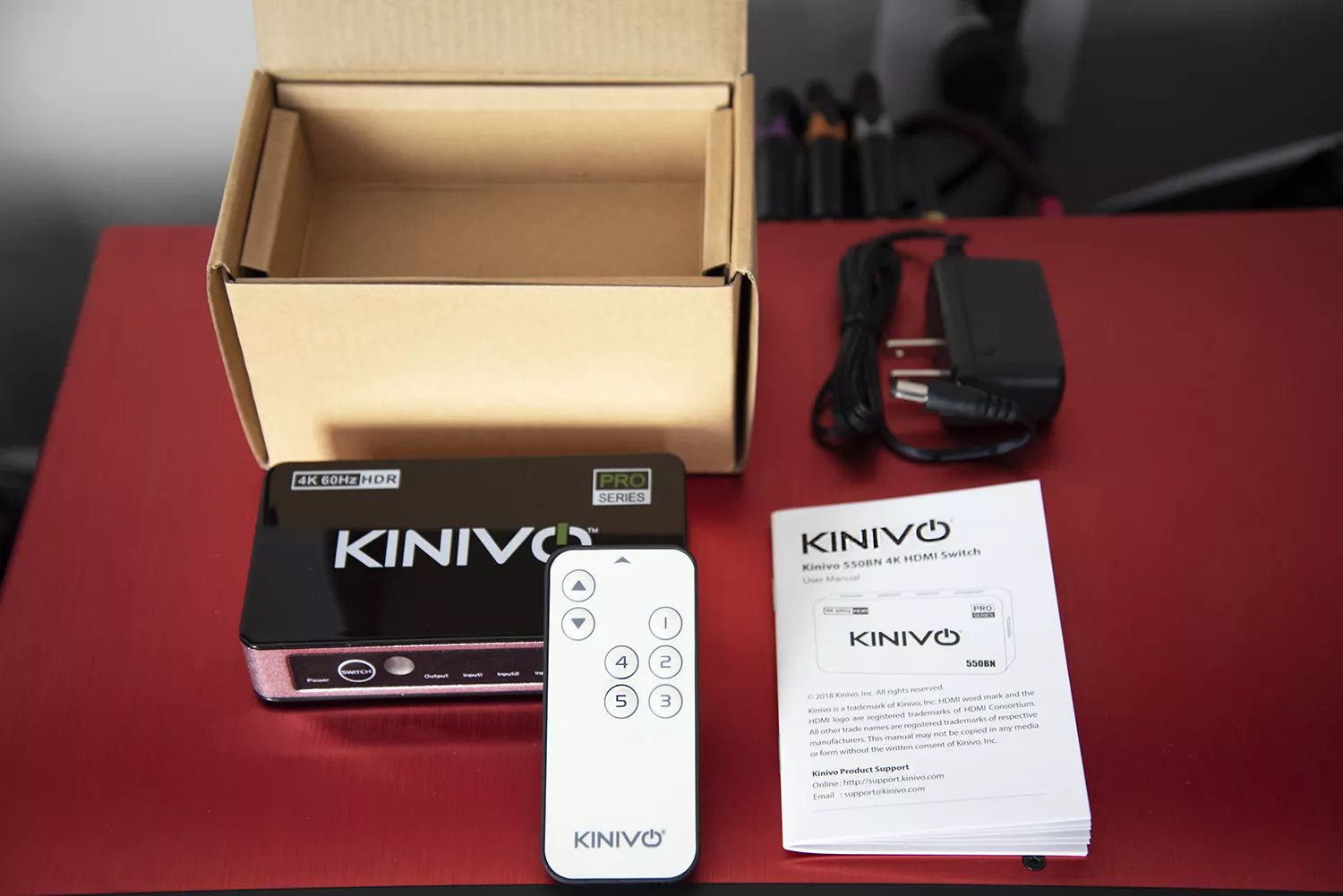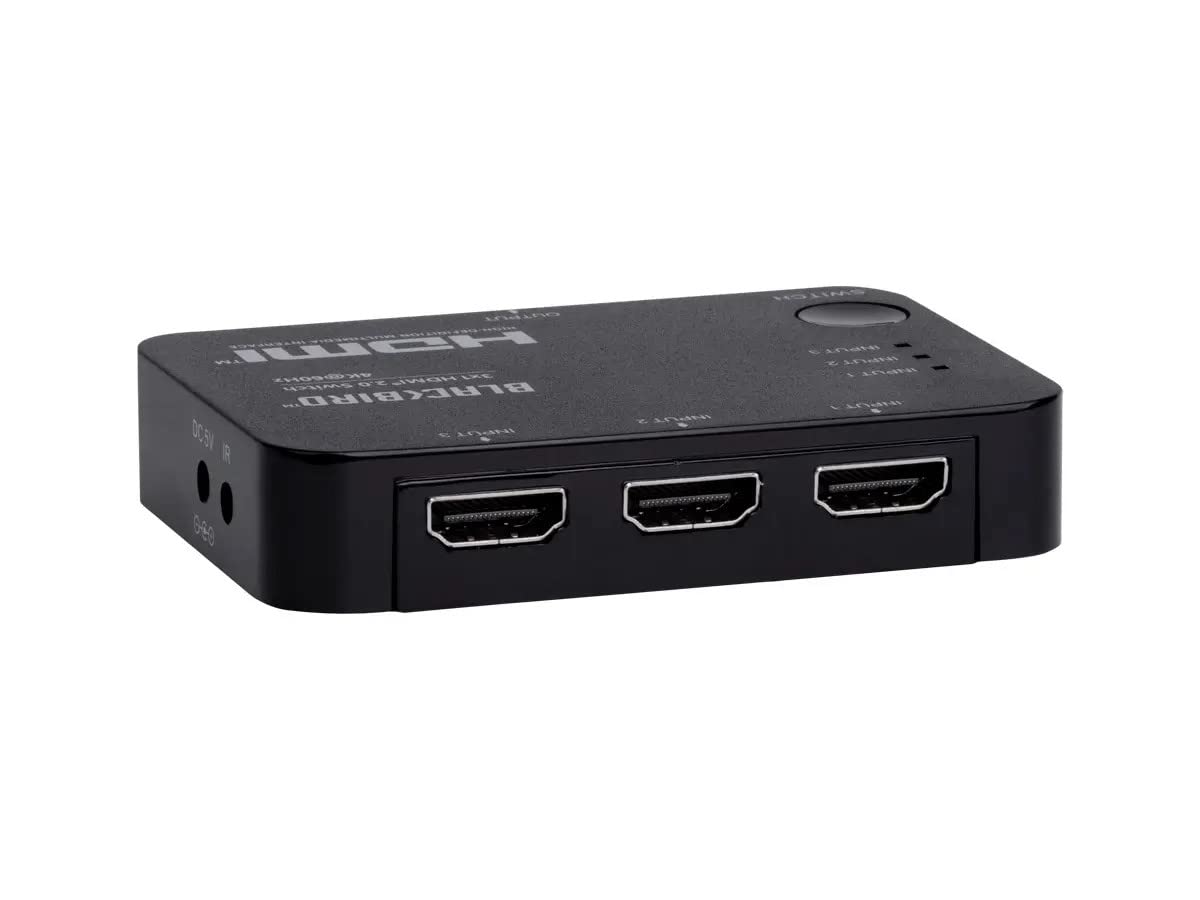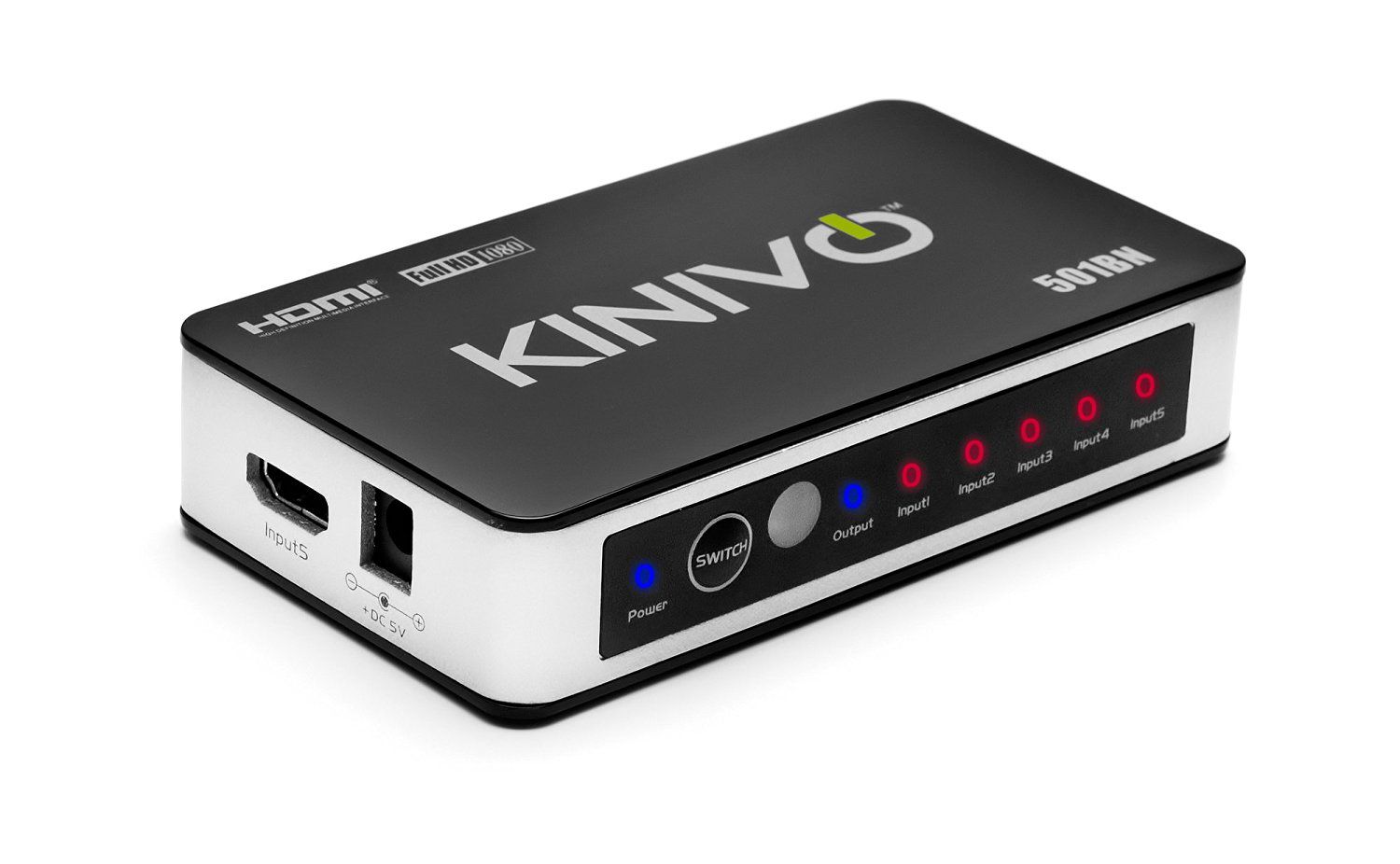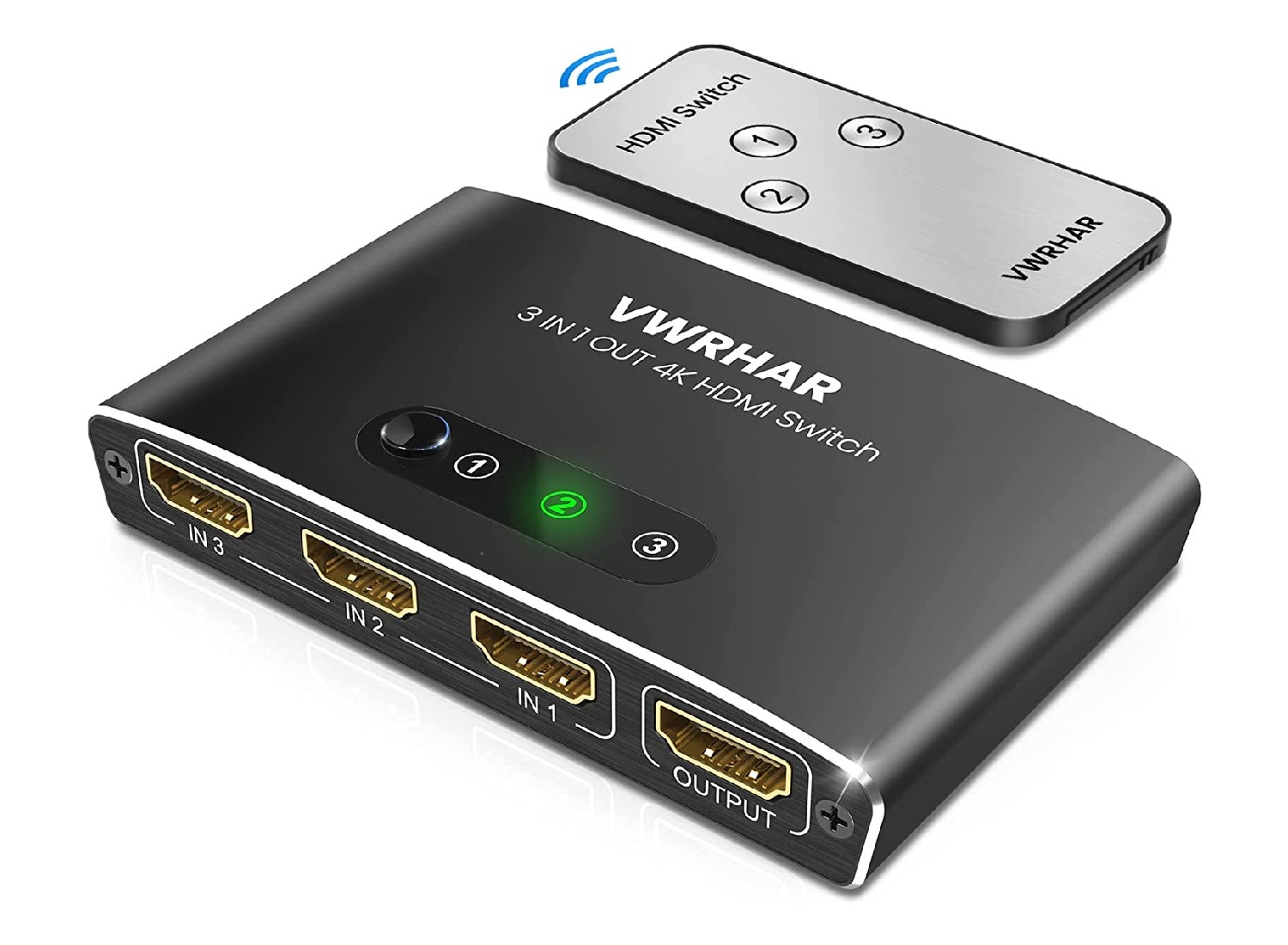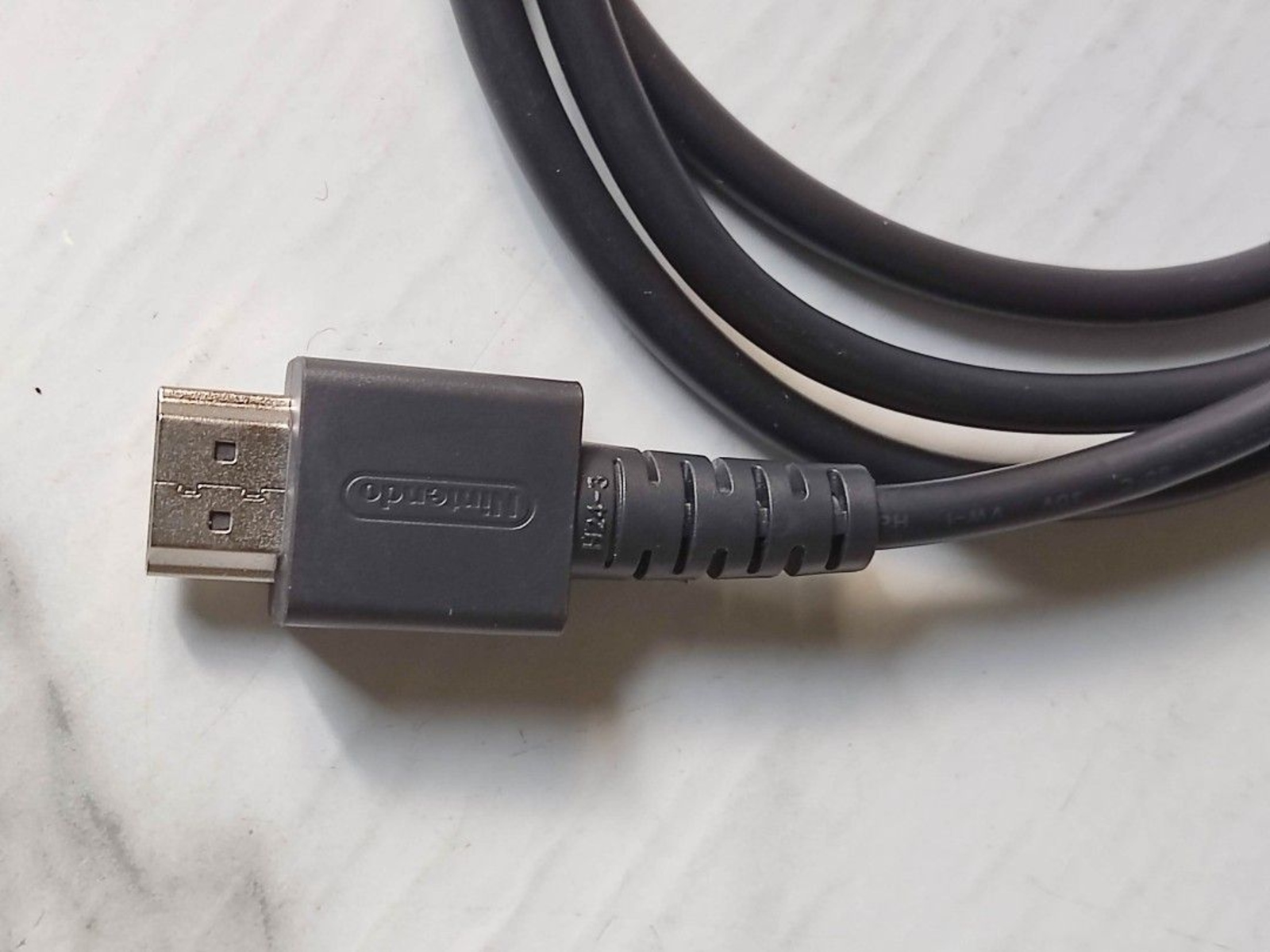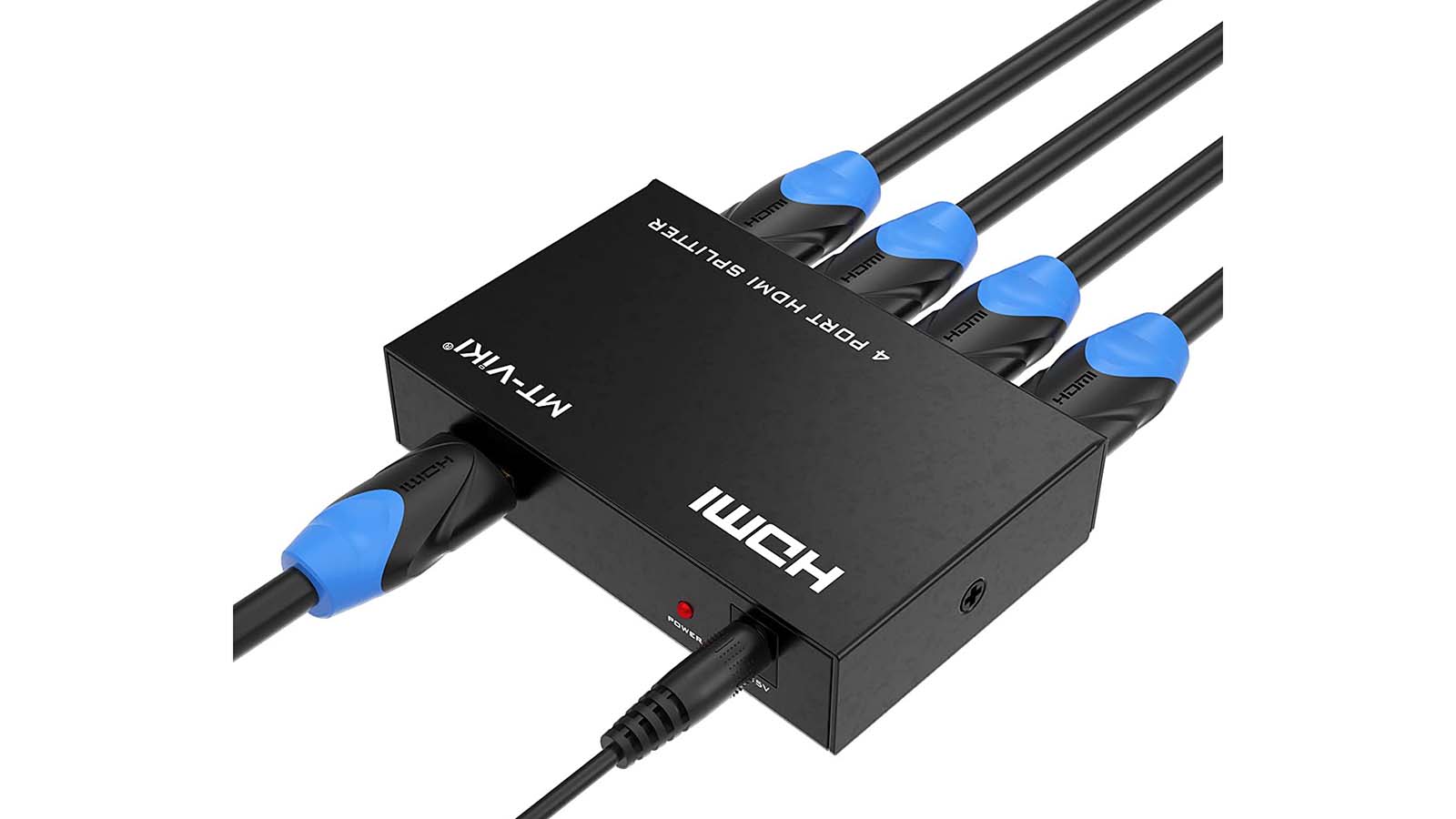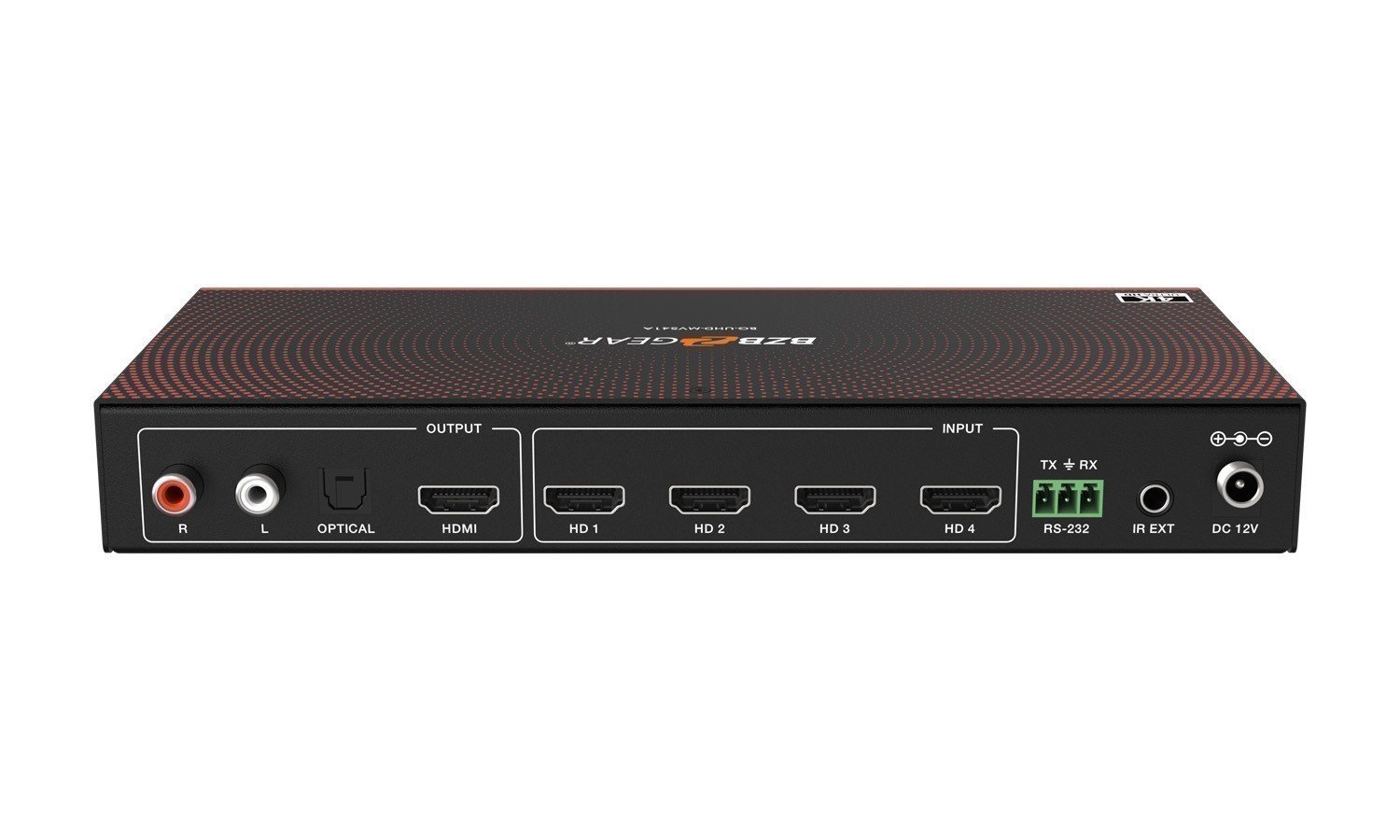Introduction
Welcome to the world of high-definition multimedia! In this digital age, we are surrounded by an abundance of devices that provide superior video and audio quality. One such technology that has revolutionized our entertainment experience is HDMI, short for High-Definition Multimedia Interface. Whether you are a movie buff, a gaming enthusiast, or simply enjoy streaming your favorite shows, understanding HDMI and its functionalities is essential.
HDMI is a widely used digital interface for transmitting high-quality video and audio signals between devices. It has become the standard connection for modern audiovisual equipment, including televisions, Blu-ray players, gaming consoles, soundbars, and projectors. With HDMI, you can enjoy stunning visuals and pristine sound quality, bringing your entertainment to life.
So, why might you need an HDMI switch? Well, as you add more devices to your setup, you may find yourself facing a shortage of HDMI ports on your TV or receiver. This is where an HDMI switch comes to the rescue! An HDMI switch allows you to connect multiple devices to a single HDMI input, eliminating the hassle of constantly swapping cables or buying additional equipment.
Imagine having your gaming console, streaming device, and Blu-ray player all connected to your TV seamlessly, with just the push of a button. With an HDMI switch, you can effortlessly switch between devices and enjoy the convenience of a clutter-free entertainment center.
Wondering how an HDMI switch actually works? It’s quite simple. When you have multiple devices connected to an HDMI switch, the switch acts as a mediator, transmitting the video and audio signals from the selected input to the output port connected to your TV or receiver. It intelligently detects which device is active and sends the appropriate signals, ensuring smooth and uninterrupted viewing pleasure.
Now that we have covered the basics, let’s delve deeper into the types of HDMI switches available, the features you should consider, how to choose the right one for your needs, and tips on setting up and troubleshooting common issues. By the end of this guide, you will have a comprehensive understanding of HDMI switches and be ready to enhance your entertainment setup!
What Is HDMI?
HDMI, which stands for High-Definition Multimedia Interface, is a digital connection standard that revolutionizes the way we transmit audio and video signals between devices. It has quickly become the go-to method for connecting modern audiovisual equipment, as it delivers high-quality, uncompressed audio and video signals, ensuring a superior viewing and listening experience.
HDMI cables carry both audio and video signals, making them a versatile and convenient option for connecting devices. They are typically used to connect devices like televisions, Blu-ray players, streaming devices, gaming consoles, computers, and sound systems.
Unlike its predecessors, such as composite or component cables, HDMI provides a single cable solution, eliminating the need for multiple cables and reducing clutter. It simplifies the process of setting up and connecting devices, offering a plug-and-play experience.
HDMI supports various video resolutions, including standard definition (SD), high definition (HD), and ultra-high definition (UHD) or 4K resolution. With HDMI, you can enjoy crisp, vibrant, and detailed images on your screen, whether you’re watching a movie, playing video games, or viewing photos.
An important aspect of HDMI is its ability to transmit high-quality audio signals. It supports multiple audio formats, including Dolby TrueHD, DTS-HD Master Audio, and more. This ensures that you can experience immersive and realistic sound when watching movies or playing games that have high-fidelity audio tracks.
Another notable feature of HDMI is its support for HDCP (High-bandwidth Digital Content Protection). HDCP is a form of digital copy protection that prevents unauthorized copying of copyrighted content. This means that HDMI provides a secure and protected connection when streaming or playing copyrighted material.
Over the years, HDMI has evolved to keep up with technological advancements. The latest version, HDMI 2.1, introduced even more capabilities, such as support for higher refresh rates, dynamic HDR, enhanced audio formats, and eARC (Enhanced Audio Return Channel) for high-quality audio transmission from the TV to an audio device.
In summary, HDMI is a versatile and robust connection standard that allows for the transmission of high-quality audio and video signals between devices. Its simplicity, compatibility, and ability to deliver stunning visuals and immersive audio have made it the preferred choice for connecting our modern entertainment devices.
Why Do You Need an HDMI Switch?
In the era of ever-expanding home entertainment setups, you may find yourself faced with a common problem – limited HDMI ports on your TV or receiver. This is where an HDMI switch becomes a valuable tool to enhance your setup and streamline your entertainment experience.
Here are a few reasons why you might need an HDMI switch:
- Limited HDMI Ports: Many TVs and receivers come with a limited number of HDMI ports, typically around two to four. With the increasing number of devices available, such as gaming consoles, streaming devices, Blu-ray players, and sound systems, you may quickly run out of available ports. An HDMI switch allows you to expand the number of devices you can connect to your TV by providing additional HDMI inputs.
- Convenience: Constantly swapping HDMI cables whenever you want to switch between devices can be a hassle. An HDMI switch eliminates the need for manual cable swapping, making it convenient to switch between devices with just the push of a button or remote control. This saves you time and effort, allowing you to focus more on enjoying your entertainment.
- Clean and Organized Setup: Having multiple devices connected directly to your TV can create a tangled mess of cables, leading to a cluttered and messy look. With an HDMI switch, you can consolidate all your devices into a single switch, reducing cable clutter and creating a clean and organized entertainment center. This not only improves the aesthetics of your setup but also makes it easier to manage and troubleshoot your devices.
- Compatibility: Different devices may come with different types of video and audio connections, such as HDMI, VGA, DVI, or component. An HDMI switch can serve as a bridge between these different connection types, allowing you to connect devices with different interfaces and still enjoy the benefits of HDMI, such as high-definition video and audio quality.
- Future-proofing: Technology is constantly advancing, and newer devices are introduced with improved features and connections. An HDMI switch ensures that you can easily upgrade your entertainment system without worrying about compatibility issues. Instead of replacing your TV or receiver with more HDMI ports, you can simply use an HDMI switch to accommodate new devices without the need for expensive upgrades.
Overall, an HDMI switch provides the flexibility, convenience, and compatibility needed to enhance your home entertainment experience. It allows you to connect multiple devices to a single HDMI input, expanding your connectivity options and simplifying the process of switching between devices. Whether you have limited HDMI ports or want to create a clean and organized setup, an HDMI switch is a must-have accessory for any modern multimedia enthusiast.
How Does an HDMI Switch Work?
An HDMI switch is a device that allows you to connect multiple HDMI sources, such as gaming consoles, streaming devices, Blu-ray players, and more, to a single HDMI display, such as a TV or projector. It acts as a mediator, intelligently routing the audio and video signals from the selected input to the output device. Understanding how an HDMI switch works will give you a clear picture of its functionality and benefits.
An HDMI switch typically consists of several HDMI input ports, an output port, and a switch mechanism. The number of input ports can vary depending on the model and brand of the switch, with options ranging from 2 to 8 or even more inputs.
When you connect your devices to the HDMI switch, each device is assigned to a specific input port. For example, you may connect your gaming console to Input 1, your streaming device to Input 2, and your Blu-ray player to Input 3.
Using the switch mechanism, you can select the device you want to display on your TV or projector. This can be done using physical buttons on the switch itself, a remote control, or automatic switching based on device activity.
When you select a particular input, the HDMI switch will send the audio and video signals from that input to the output port, which is then connected to your TV or projector. The switch intelligently detects which device is active and routes the appropriate signals, allowing you to enjoy the desired content on your display.
Some advanced HDMI switches come with additional features, such as picture-in-picture (PiP), which allows you to display multiple sources simultaneously on your TV screen. This can be useful when you want to monitor multiple devices or view content from different sources at the same time.
HDMI switches support various video and audio formats, including standard definition (SD), high definition (HD), and ultra-high definition (UHD) or 4K resolution. They also support different audio formats, such as Dolby TrueHD, DTS-HD Master Audio, and more, ensuring that you get the best possible audio and video quality from your connected devices.
In summary, an HDMI switch acts as a central hub that allows you to connect multiple HDMI sources to a single HDMI display. By selecting the desired input, the switch intelligently routes the audio and video signals from that input to the output port, enabling you to conveniently switch between devices and enjoy your desired content on the screen. With its ease of use and seamless signal transmission, an HDMI switch is an essential tool for those who have multiple HDMI devices and limited HDMI ports on their display.
Types of HDMI Switches
When it comes to HDMI switches, there are several different types available, each catering to specific needs and requirements. Understanding the various types of HDMI switches will help you choose the one that best suits your setup and preferences.
1. Standard HDMI Switch: The standard HDMI switch is the most common type and is suitable for basic home entertainment setups. It typically comes with two to four HDMI input ports and a single HDMI output port. This type of switch allows you to connect multiple devices to a single display, making it convenient for those with limited HDMI ports on their TV or receiver.
2. Automatic HDMI Switch: An automatic HDMI switch is designed to simplify the switching process by automatically detecting and selecting the active input. This means that when you turn on a connected device, the switch will automatically display its content on the screen. It eliminates the need for manually selecting the input and provides a seamless viewing experience. Automatic HDMI switches are great for those who want a hassle-free setup and effortless switching between devices.
3. Remote-Controlled HDMI Switch: As the name suggests, a remote-controlled HDMI switch allows you to switch between different inputs using a remote control. This type of switch gives you the convenience of switching devices from the comfort of your couch, without having to physically interact with the switch itself.
4. Matrix HDMI Switch: A matrix HDMI switch offers more advanced functionality compared to standard switches. It allows you to connect multiple input devices to multiple displays, offering a versatile and flexible configuration. For example, you can connect four devices to four different TVs or projectors and independently switch each device to any display. This type of switch is particularly useful in situations where you want to distribute audio and video signals to multiple rooms or displays simultaneously.
5. 4K HDMI Switch: With the increasing availability of 4K UHD content, having a switch that supports this resolution is essential for those who want to enjoy the highest level of detail and clarity. A 4K HDMI switch allows you to connect and switch between 4K-compatible devices, ensuring that you can fully utilize the capabilities of your 4K TV or projector.
6. HDMI Switch with Audio Extraction: This type of switch not only allows you to switch between HDMI inputs but also has the ability to extract audio from the HDMI signal. It enables you to connect your HDMI source to an external audio system, such as a soundbar or AV receiver, and enjoy enhanced audio quality while still transmitting the video signal to your display. This is particularly useful if you have a sound system that does not have HDMI inputs.
Each type of HDMI switch offers different features and functionalities, so it’s important to consider your specific needs and setup requirements when choosing the right one for you. Whether you need a basic switch for everyday use, an automatic switch for convenience, or a matrix switch for advanced configurations, there is an HDMI switch available to enhance your home entertainment experience.
Features to Look for in an HDMI Switch
When choosing an HDMI switch, there are several key features that you should consider to ensure that it meets your specific needs and provides the best possible experience for your home entertainment setup. Here are some important features to look for:
- Number of HDMI Inputs: Determine how many HDMI devices you need to connect to the switch. Consider both your current devices and any future additions you may have in mind. Choose a switch that offers enough HDMI inputs to accommodate all your devices.
- HDMI Version: Check the HDMI version supported by the switch. The latest version, HDMI 2.1, offers features like 4K resolution, higher refresh rates, and enhanced audio formats. Even if your current devices may not utilize these features, opting for a switch with HDMI 2.1 ensures future compatibility and support for upcoming devices.
- Resolution and Audio Support: Ensure that the switch supports the video and audio resolutions of your devices. Look for features like support for 4K resolution, HDR (High Dynamic Range), and audio formats like Dolby TrueHD or DTS-HD Master Audio, depending on your preferences and the capabilities of your devices.
- Switching Mechanism: Consider the switching mechanism of the HDMI switch. Look for options like remote control, automatic input detection, or manual switching buttons. Choose a mechanism that aligns with your convenience and ease of use.
- Compatibility: Check the compatibility of the HDMI switch with your devices. Ensure that it supports the HDMI version and specifications of your TV, projector, gaming console, sound system, and other connected devices. This will ensure optimal performance and compatibility across your entire setup.
- Passthrough of Additional Signals: Some HDMI switches offer additional features, such as support for Ethernet over HDMI (HEC), Audio Return Channel (ARC), or Consumer Electronics Control (CEC). These features can provide added convenience and functionality, allowing you to streamline your setup and control devices using a single remote or utilize network connectivity.
- Build Quality and Design: Consider the build quality and design of the HDMI switch. Look for switches that are well-built, durable, and have proper ventilation to prevent overheating. Additionally, consider the size and form factor of the switch to ensure it fits neatly into your entertainment center.
- Price and Brand Reputation: Compare the prices and read reviews of different HDMI switches. Consider the reputation and reliability of the brand to ensure you are investing in a quality product that will provide long-term satisfaction and support.
By considering these features and factors, you can choose an HDMI switch that not only meets your current needs but also offers room for future expansion and compatibility. A well-chosen HDMI switch will enhance the functionality and convenience of your home entertainment setup, providing seamless switching between devices and ensuring the best possible audiovisual experience.
How to Choose the Right HDMI Switch for Your Needs
Choosing the right HDMI switch can significantly enhance your home entertainment setup, providing convenience, flexibility, and improved connectivity. To ensure that you select the most suitable HDMI switch for your needs, consider the following factors:
- Number of Devices: Determine how many HDMI devices you need to connect to the switch. Take into account both your existing devices and any potential future additions. Choose a switch that offers enough HDMI inputs to accommodate all your devices.
- Supported Resolutions: Check the resolution capabilities of both your devices and the HDMI switch. Ensure that the switch supports the maximum resolution your devices are capable of, whether it’s HD, 4K, or even higher resolutions for future-proofing your setup.
- Audio Support: Consider the audio formats supported by the HDMI switch. If you have devices that output advanced audio formats like Dolby Atmos or DTS:X, make sure the switch can pass through these audio signals without any degradation in quality.
- Switching Mechanism: Decide on the type of switching mechanism that suits your preferences. Remote-controlled switches provide convenience, while automatic switches intelligently detect and switch to the active device. Manual switches require physical interaction but may offer more control.
- Compatibility: Ensure that the HDMI switch is compatible with your devices, especially if you have specific brand or model requirements. Check if the switch supports the HDMI version and specifications of your TV, gaming console, streaming device, and other equipment.
- Additional Features: Consider any additional features that would be beneficial for your setup. This could include support for Ethernet over HDMI, Audio Return Channel, or Consumer Electronics Control. These features can enhance connectivity and streamline your home entertainment system.
- Budget: Set a budget that suits your requirements and compare the pricing of different HDMI switches. While it’s important to consider affordability, prioritize quality and functionality to ensure a reliable and satisfactory experience.
- Reviews and Ratings: Read customer reviews and ratings of the HDMI switch you’re interested in. This will provide insights into the reliability, performance, and user experience associated with the product. Pay attention to reviews from customers with similar setup requirements.
By considering these factors, you can make an informed decision and choose an HDMI switch that aligns with your specific needs and preferences. Remember to prioritize the features that are most important to you and invest in a reputable brand known for delivering reliable and high-quality products. With the right HDMI switch, you can optimize your home entertainment setup, enjoy seamless device switching, and elevate your audiovisual experience to new heights.
Setting Up and Using an HDMI Switch
Setting up and using an HDMI switch is a relatively straightforward process that can greatly enhance your home entertainment experience. Here’s a step-by-step guide to help you get started:
- Choose the Right HDMI Switch: Select an HDMI switch that meets your requirements, considering the number of devices you want to connect, supported resolutions, audio capabilities, switching mechanism, and compatibility with your devices.
- Gather the Necessary Cables: Ensure you have sufficient HDMI cables to connect your devices to the HDMI switch. Measure the length needed for each cable to reach the switch comfortably.
- Connect the HDMI Switch to Your Display: Locate an available HDMI input port on your TV or receiver and connect one end of an HDMI cable to the HDMI output port of the switch. Connect the other end of the HDMI cable to the HDMI input port on your display device.
- Connect Your Devices to the HDMI Switch: Connect each of your devices to the HDMI input ports of the switch using HDMI cables. Ensure that each device is connected to the appropriate labeled input on the switch.
- Power Up the HDMI Switch: Plug the HDMI switch into a power source using the provided power adapter. Some HDMI switches are powered through the HDMI connection, eliminating the need for a separate power supply.
- Select the Desired HDMI Input: Depending on the switch’s switching mechanism, use the remote control, manual buttons on the switch, or automatic input detection to select the desired HDMI input. The chosen device’s content should now be visible on your display.
- Switch Between Devices: To switch between different devices connected to the HDMI switch, use the chosen switching mechanism. The switch will route the audio and video signals from the selected input to the output, allowing you to enjoy content from the desired device.
- Additional Settings: Depending on your specific HDMI switch model, you may have access to additional settings and features. Refer to the user manual of the switch for instructions on how to access and configure these settings.
- Audio and Video Settings: Check the audio and video settings on your TV or receiver to ensure they are properly configured for optimal performance. Set the resolution, audio output format, and other settings based on the capabilities of your devices and personal preferences.
- Testing and Troubleshooting: After setting up your HDMI switch, test each device to ensure they are functioning correctly. If you encounter any issues, refer to the troubleshooting section of the HDMI switch’s user manual or consult the manufacturer’s support resources for guidance.
Following these steps will help you set up and use your HDMI switch effectively, providing a seamless and convenient solution for connecting multiple devices to your display. Enjoy the flexibility of switching between devices effortlessly and improving the overall entertainment experience in your home.
Troubleshooting Common HDMI Switch Issues
While HDMI switches can greatly enhance your home entertainment setup, it’s not uncommon to encounter some issues along the way. Here are some common problems you may face when using an HDMI switch and troubleshooting steps to help resolve them:
- No Signal or Poor Quality: If you’re experiencing a loss of signal or poor video/audio quality, check the HDMI cables for any loose connections or damage. Ensure that all cables are securely plugged into the switch and the connected devices. If necessary, replace the HDMI cables with high-quality ones to ensure a stable connection.
- Device Compatibility: Verify that all devices connected to the HDMI switch are compatible with the switch and each other. Some older devices may have compatibility issues with newer HDMI switch models or specific features such as 4K resolution or advanced audio formats. Check the specifications and ensure all devices meet the required standards.
- Device Recognition: If the HDMI switch is not recognizing one or more devices connected to it, try unplugging and reconnecting the HDMI cables for the affected devices. Power cycle both the switch and the problematic device by turning them off and on again. If the issue persists, try connecting the problematic device directly to the display to verify if it’s an issue with the device itself.
- Switching Problems: If you’re having trouble switching between devices, check the HDMI switch’s manual or remote control for the proper switching instructions. Ensure that you’re using the correct button or command to select the desired HDMI input. If the switch has automatic input detection, ensure that the active device is powered on and sending a signal to the switch.
- Power Cycle the HDMI Switch: If you’re experiencing general connectivity issues, a simple power cycle of the HDMI switch can often resolve the problem. Disconnect the power supply from the switch, wait for a few seconds, and then reconnect it. This process can help refresh the switch’s internal firmware and restore proper functionality.
- Software/Firmware Updates: Check if there are any available software or firmware updates for your HDMI switch. Manufacturers often release updates to address compatibility issues, improve performance, or add new features. Consult the manufacturer’s website or support resources for any available updates and follow their instructions to install them.
- Signal Interference: If you notice distortions or signal disruptions, particularly with wireless devices like a gaming console or streaming device, consider the presence of other electronic devices that may be causing interference. Move any nearby devices away from the HDMI switch and check if the issue improves.
- Try a Different HDMI Switch: If all troubleshooting steps fail, and multiple devices experience consistent issues, it’s possible that the HDMI switch itself is defective. In such cases, consider testing with a different HDMI switch to determine if the problem lies with the switch. If the issues persist with multiple switches, it may be worth consulting a professional or contacting the manufacturers for further support.
By following these troubleshooting steps, you can often resolve common HDMI switch issues and enjoy a seamless experience with your connected devices. Remember to always refer to the user manual or contact the manufacturer’s support resources for specific guidance related to your HDMI switch model.
Conclusion
HDMI switches are valuable tools that enhance the functionality and convenience of your home entertainment setup. By allowing you to connect multiple HDMI devices to a single display, HDMI switches eliminate the need for constant cable swapping and provide a streamlined and organized entertainment center.
Through this guide, we have explored the fundamentals of HDMI technology, the benefits of using an HDMI switch, and the key factors to consider when choosing the right switch for your needs. We have also covered how to set up and use an HDMI switch, as well as troubleshoot common issues that may arise.
By understanding the various types of HDMI switches available, such as standard switches, automatic switches, matrix switches, and more, you can select one that aligns with your requirements and preferences. Take into account factors like the number of HDMI inputs needed, supported resolutions, audio capabilities, switching mechanisms, and compatibility with your devices.
Setting up an HDMI switch involves connecting your devices to the switch, connecting the switch to your display, and selecting the desired input. With the right HDMI switch in place, you can effortlessly switch between devices, enjoy high-quality audiovisual experiences, and maintain a clean and organized entertainment area.
In the event of any issues, familiarize yourself with troubleshooting techniques such as checking cable connections, verifying device compatibility, power cycling the switch, and updating firmware if necessary. These steps can help resolve common problems and ensure the smooth operation of your HDMI switch.
Overall, HDMI switches offer a convenient solution for managing multiple HDMI devices, maximizing your entertainment options, and simplifying your setup. They provide flexibility, compatibility, and improved connectivity, enabling you to make the most of your home entertainment system.
With the knowledge gained from this guide, you are now equipped to choose the right HDMI switch for your needs, set it up effectively, and troubleshoot any issues that may arise. Embrace the convenience and versatility that HDMI switches bring, and elevate your home entertainment experience to new heights.







